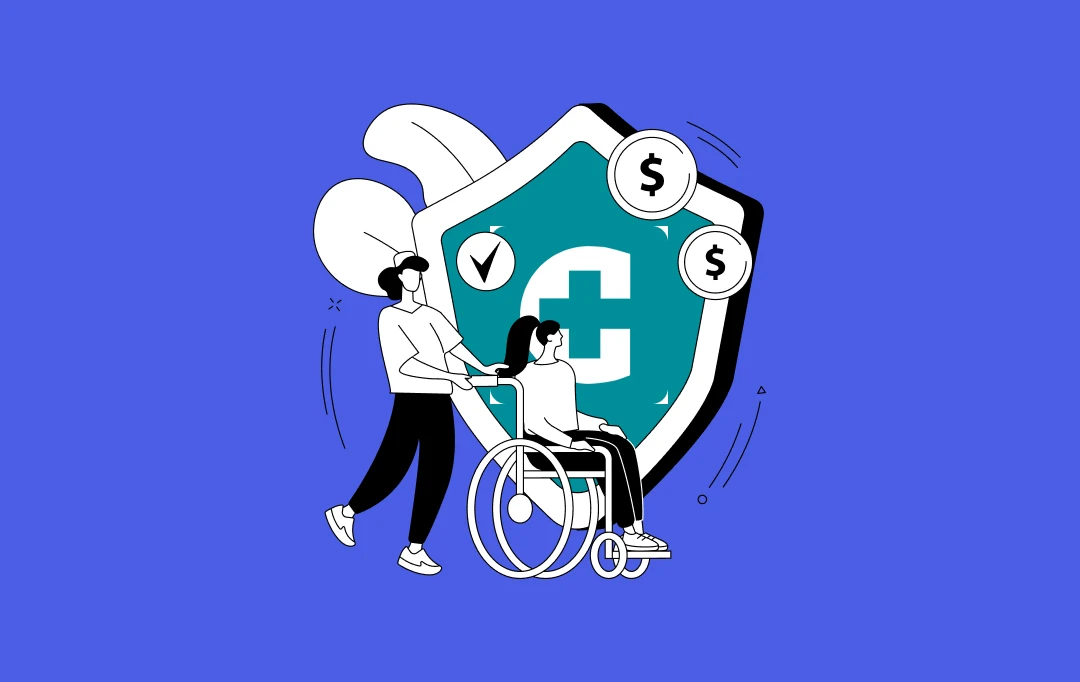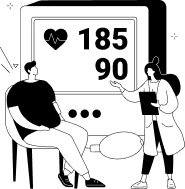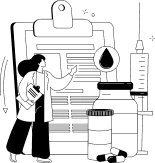- The Digital Healthcare Shift - Why Are Patients Demanding Apps Like Lumi
- Cost Breakdown of Building an App Like Lumi by Nextcare
- Basic Healthcare Assistance App (Limited Features, Small User Base)
- Mid-Level Healthcare App (Telehealth, Insurance Integration, AI-Driven Support)
- High-End Healthcare Platform (Enterprise-Level, Compliance-Ready, Scalable)
- Factors Affecting the Cost of Developing A Health Insurance App Like Lumi by Nextcare
- Prioritize Core Features
- Implement Cross-Platform Development
- Use Healthcare APIs and Third-Party Integrations
- Leverage Cloud Solutions
- Must-Have Features for Building an App Like Lumi by Nextcare
- View Policy Benefits and Instantly Generate Certificates
- AI-Powered Symptom Checker for Pre-Diagnosis
- Secure and Instant Video Consultations with Doctors
- Virtual Assistance for Quick Medical Guidance
- Streamlined Medical Claims Submission and Real-Time Tracking
- Healthcare Provider Directory and Appointment Booking
- Medication Ordering and Home Delivery
- Design Considerations for Lumi by Nextcare
- Simplicity and Accessibility for All Users
- Secure and Streamlined Claims Process
- Integrated Video Consultation Interface
- Personalized Healthcare Journey
- Real-Time Appointment Scheduling and Notifications
- Integration with Health Ecosystem and Partners
- Visual Design that Inspires Trust and Calmness
- Health Data Privacy and Transparency
- Patient Education and Support Resources
- Tech Stack for Building an App Like Lumi by Nextcare
- The Development Process for Building an App Like Lumi by Nextcare
- Agile Development (Most Recommended for Healthcare Apps)
- Waterfall Development (Less Suitable for Healthcare Apps)
- MVP (Minimum Viable Product)
- How to Earn Money From Your Lumi by Nextcare App
- Subscription-Based Model
- Pay-Per-Consultation or Transactional Fees
- Partnerships with Healthcare Providers
- Health Insurance Integration & Commission
- Data Analytics & Insights for Healthcare Providers
- How can Appinventiv Elevate Your Healthcare App Development?
- FAQs
Healthcare is no longer confined to clinics and hospitals – digital solutions like Lumi by Nextcare transform patient experiences by bringing essential services to their fingertips. From virtual assistance and symptom checking to booking appointments and managing insurance claims, Lumi streamlines multiple aspects of the healthcare journey within a single app. This level of integration enhances patient convenience and reduces administrative burdens for healthcare providers and insurers.
Building an app with similar capabilities requires careful consideration of both technology and compliance.
On the one hand, the Lumi-like app must support real-time video consultations, AI-powered symptom assessments, and seamless integration with insurance providers for claims processing. Conversely, it should offer secure data management, ensuring compliance with HIPAA or other regional healthcare regulations. Combined with an intuitive UI/UX and a robust backend, these features can significantly influence the overall Lumi by Nextcare app development cost.
Beyond the initial build, ongoing costs such as cloud hosting, cybersecurity, API integrations with healthcare networks, and system maintenance must be factored in. This article provides a detailed breakdown of the app, like Lumi by Nextcare development cost components, which are between $50,000 and $700,000, helping you understand the investment required to bring such a solution to market.
Don’t miss out on creating an impact today.
The Digital Healthcare Shift – Why Are Patients Demanding Apps Like Lumi
Healthcare has long been burdened by inefficiencies, from endless paperwork to unclear insurance policies. The frustration is real: A recent survey found that 60% of patients abandon healthcare providers due to poor digital experiences. When entrepreneurs develop an app like Lumi by Nextcare, they bridge this gap, offering patients a one-stop digital solution for managing medical needs without unnecessary delays or confusion.
One of the most significant changes in patient expectations is the demand for self-service healthcare. People no longer want to wait on hold to check their policy benefits or chase down medical claims through complex bureaucracies. They expect instant access to their healthcare information, whether booking an appointment, tracking a claim, or issuing a certificate, all from a user-friendly interface. The success of efforts you put in to create a health insurance app like Lumi by Nextcare lies in its ability to provide this convenience, setting a benchmark for what modern healthcare apps should offer.
Moreover, trust and transparency have become non-negotiable in the healthcare space. Patients want real-time updates on their medical claims, visibility into healthcare provider networks, and the assurance that their sensitive data is protected.
A healthcare insurance app like Lumi by Nextcare isn’t just about digitizing processes and giving users control over their healthcare journey. Businesses looking to develop a similar app must recognize that healthcare technology isn’t just a cost-saving tool for providers; it’s a patient empowerment tool that shapes trust, retention, and long-term engagement.
Cost Breakdown of Building an App Like Lumi by Nextcare
An app similar to Lumi by Nextcare requires a seamless user interface, secure infrastructure, compliance with regulations (such as HIPAA/GDPR), and integration with insurers and healthcare providers. Given the sensitive nature of patient data and the demand for real-time interactions, health insurance app development costs are significantly influenced by security protocols, backend complexity, and cloud architecture.
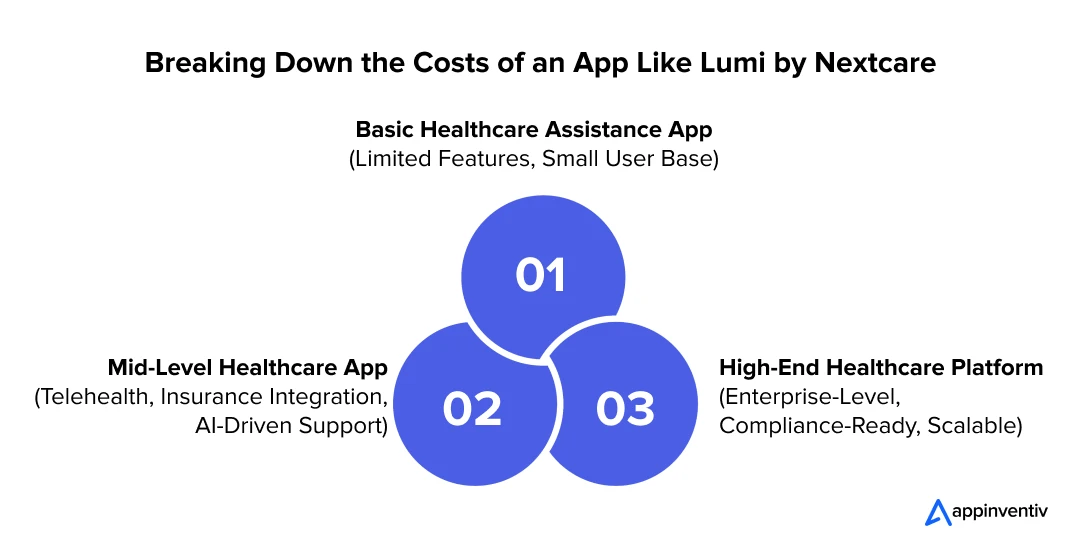
Basic Healthcare Assistance App (Limited Features, Small User Base)
Range: $50,000 – $100,000
What You Get: A basic platform with virtual assistance, appointment booking, and symptom checking. Best suited for small healthcare providers or pilot projects.
Mid-Level Healthcare App (Telehealth, Insurance Integration, AI-Driven Support)
Range: $120,000 – $250,000
What You Get: A more advanced version with video consultations, secure medical record access, AI-powered triage, and integration with insurance claim tracking systems.
High-End Healthcare Platform (Enterprise-Level, Compliance-Ready, Scalable)
Range: $300,000 – $700,000+
What You Get: A full-fledged, compliance-driven solution with multi-country support, advanced security layers, blockchain-based patient records, automated claims processing, and deep analytics for healthcare providers.
Additionally, healthcare apps require continuous monitoring, compliance audits, and cloud security upgrades, which can up the cost to build a health insurance app like Lumi by Nextcare by an extra $20,000 – $100,000 annually based on the app’s scale and data storage needs.
Factors Affecting the Cost of Developing A Health Insurance App Like Lumi by Nextcare
When you make an app like Lumi by Nextcare, it involves considerable costs, but with the right strategies, you can optimize the budget without compromising quality:
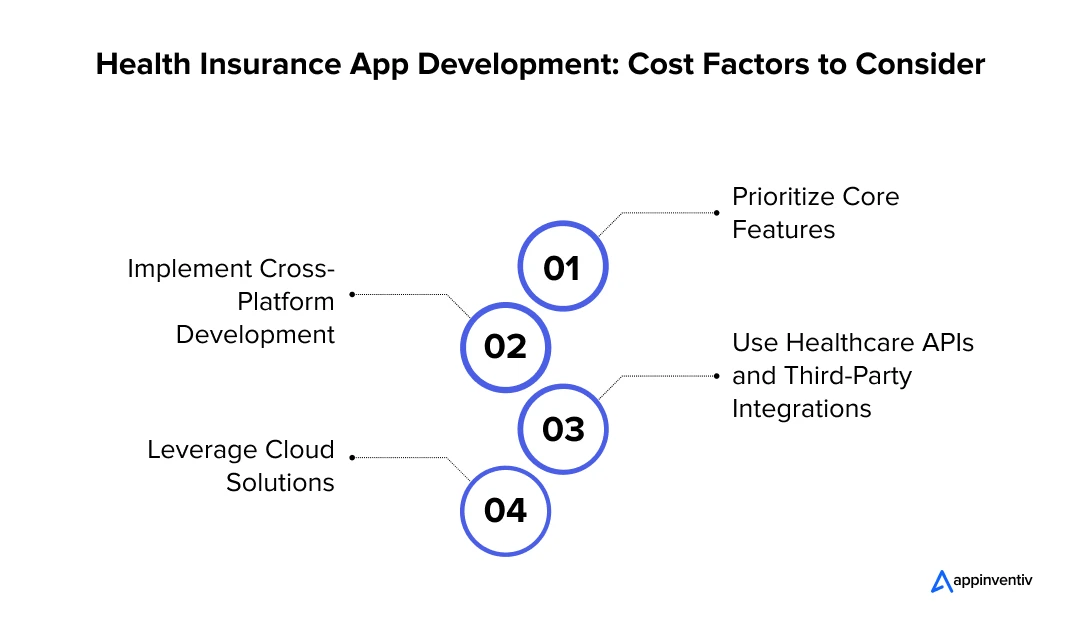
Prioritize Core Features
Focus on critical features like symptom checkers, video consultations, and appointment booking for the MVP. Additional features can be added later based on user feedback.
Implement Cross-Platform Development
Cross-platform frameworks like Flutter or React Native allow you to develop for iOS and Android, reducing development time and costs.
Use Healthcare APIs and Third-Party Integrations
Integrate with third-party APIs such as Twilio Video for video consultations and Redox for medical records to save on custom development.
Leverage Cloud Solutions
Platforms like AWS or Google Cloud provide scalable, cost-effective cloud services, ensuring security and compliance without costly infrastructure.
Must-Have Features for Building an App Like Lumi by Nextcare
In today’s healthcare landscape, convenience, accessibility, and security influence patient choices. The Lumi by Nextcare app features are built to simplify medical processes, from symptom checking to virtual consultations and insurance claims management. Unlike traditional healthcare apps focusing solely on appointment booking, Lumi is a one-stop solution for managing health, insurance, and medication needs, all from a single platform.
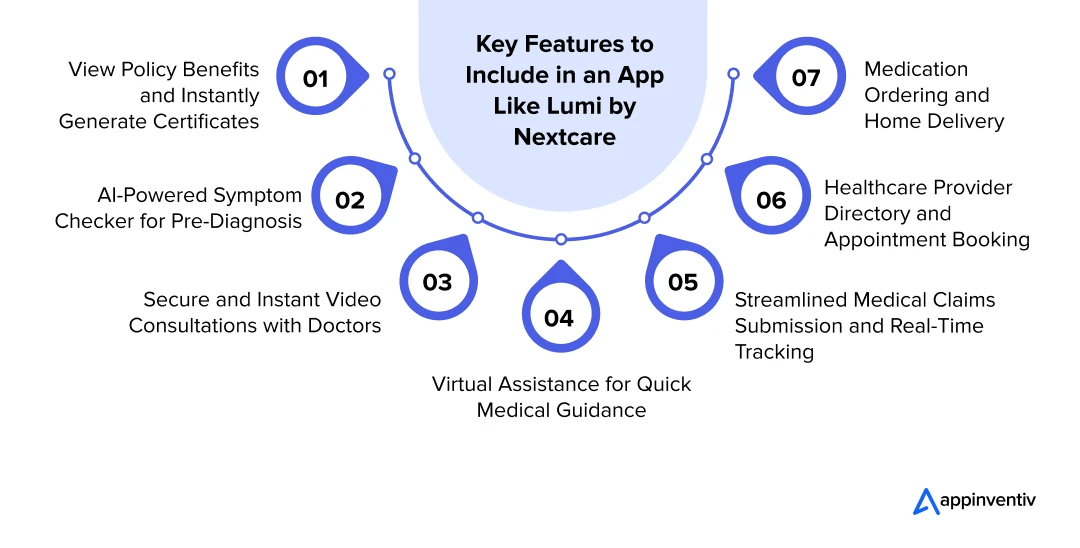
View Policy Benefits and Instantly Generate Certificates
Insurance coverage can be complex, with policyholders often struggling to find relevant details. When you invest in insurance mobile app development for healthcare industry, like Lumi, address this by allowing users to instantly view their policy benefits, including coverage details, copay amounts, and exclusions. Additionally, users can generate and download insurance certificates within seconds, reducing the hassle of manual paperwork when proof of coverage is required.
AI-Powered Symptom Checker for Pre-Diagnosis
Before booking an appointment, users can assess their symptoms using Lumi’s AI-driven symptom checker. This feature provides preliminary health insights based on medical databases, helping users determine whether they need a doctor’s visit, a teleconsultation, or self-care. While it does not replace a professional diagnosis, it empowers users with better health awareness and encourages proactive decision-making.
Secure and Instant Video Consultations with Doctors
Virtual healthcare has become essential, and Lumi facilitates real-time video consultations with licensed doctors. Users can schedule an appointment within minutes and consult a physician from the comfort of their homes. The app ensures HIPAA-compliant encryption for video calls, safeguarding patient privacy and medical records.
Virtual Assistance for Quick Medical Guidance
Navigating healthcare systems, understanding treatment plans, or managing insurance claims can be overwhelming. Lumi by Nextcare app features solve this by including a 24/7 virtual assistant that helps users with inquiries related to coverage eligibility, claim submission, appointment scheduling, and general medical questions. This reduces the need for long wait times on customer support calls, making healthcare more accessible.
Streamlined Medical Claims Submission and Real-Time Tracking
One of the most frustrating aspects of healthcare is dealing with insurance claims. Lumi health insurance app for patients eliminates paperwork by allowing users to submit claims digitally through the app. The platform also provides real-time updates on claim status, helping patients track approvals, reimbursements, or denials instantly. This transparency builds trust and ensures faster claim processing.
Healthcare Provider Directory and Appointment Booking
Finding the right specialist can be time-consuming. Lumi simplifies this by offering a comprehensive directory of healthcare providers, enabling users to search by specialty, location, availability, and insurance compatibility. Booking an appointment is just a few taps away, reducing friction in the patient journey.
Medication Ordering and Home Delivery
An app similar to Lumi by Nextcare enhances convenience further by partnering with pharmacies to offer home delivery of prescribed medications. Users can upload prescriptions, compare prices, and schedule deliveries through the app, ensuring they never run out of essential medicines. This is particularly beneficial for elderly patients, individuals with chronic conditions, or those with mobility issues.
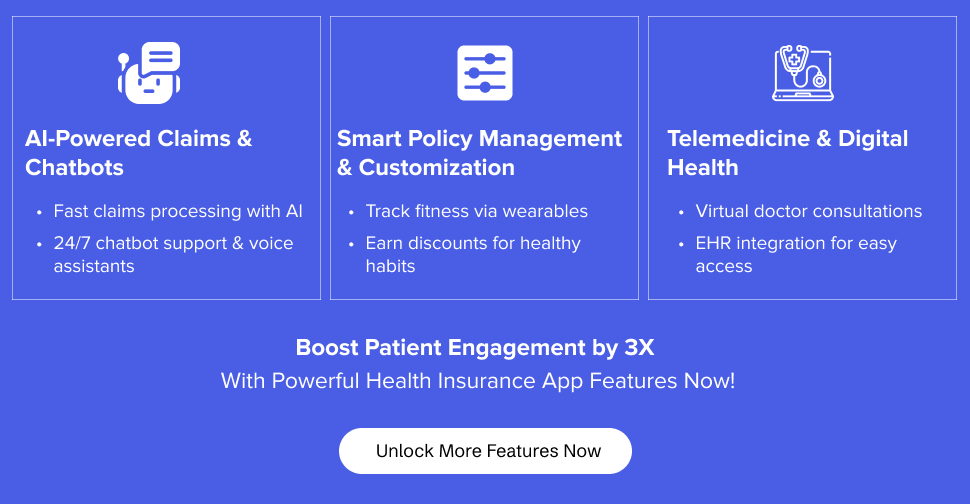
When you develop an app like Lumi by Nextcare with these features, you redefine the digital healthcare experience, making medical services more accessible, efficient, and patient-centric, especially because it is Lumi’s ability to integrate insurance, telehealth, symptom analysis, and medication management that sets it apart as a comprehensive health-tech solution rather than just another appointment-booking app.
Design Considerations for Lumi by Nextcare
When designing an app like Lumi by Nextcare, which serves a vital role in the healthcare ecosystem, the focus should be on ensuring seamless access to medical services while prioritizing user trust, security, and accessibility.
Even though it impacts the app like Lumi by Nextcare development cost, the wide range of functionalities that the app offers, from booking doctor appointments to submitting claims and conducting video consultations, deserves a design choice that must cater to both the tech-savvy and those unfamiliar with advanced technology.
This is especially important in healthcare, where user experience can directly impact well-being and patient engagement. The design should, therefore, not only be intuitive but also provide a sense of confidence and reliability to the user.
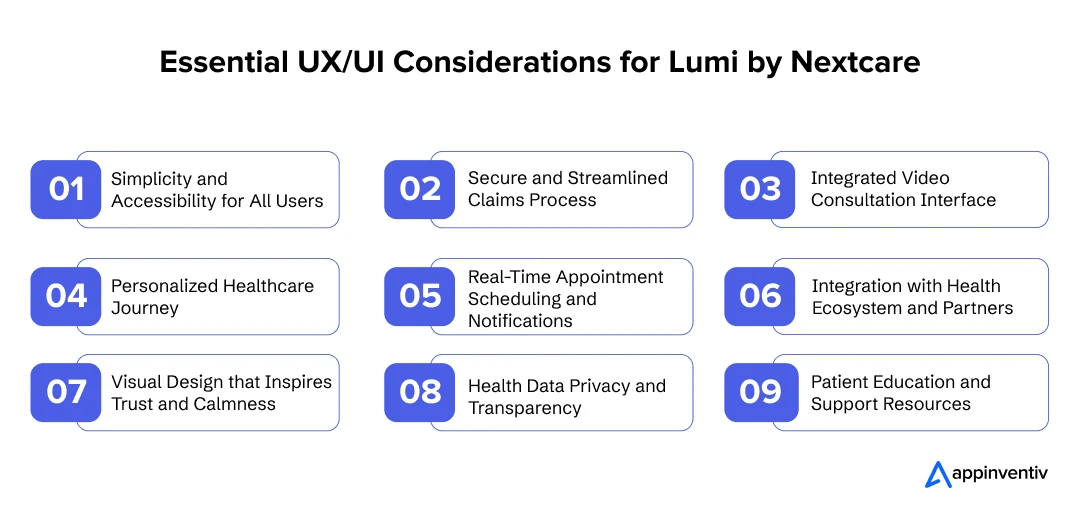
Simplicity and Accessibility for All Users
Given that healthcare insurance app like Lumi by Nextcare caters to users from various demographics, including those with minimal digital literacy, the design should be streamlined to reduce complexity.
A way to achieve that is by incorporating elements such as large fonts, easy-to-understand icons, and voice commands to make the app more accessible to users with disabilities or limited technical knowledge. Furthermore, the app should be compatible with screen readers to accommodate visually impaired users, ensuring it is truly inclusive.
Secure and Streamlined Claims Process
Security is non-negotiable when dealing with sensitive healthcare data. Your insurance mobile app development for healthcare industry efforts must provide a seamless, secure environment for users to submit and track their medical claims. The design must include clear, step-by-step instructions for claim submissions, ensuring users are guided through the process without confusion.
Including an easy-to-navigate dashboard with claim status updates and the ability to upload necessary documents (e.g., receipts, prescriptions) that should be presented in a health insurance app for insurance companies would also make tracking claims more manageable. Real-time progress indicators, such as a claims status bar, can further enhance the user experience, providing them with timely feedback.
Integrated Video Consultation Interface
With telemedicine becoming a vital aspect of modern healthcare, your design must prioritize a smooth and intuitive video consultation experience. This means the video interface should be minimalistic, allowing users to focus on the conversation rather than navigating through menus.
Additionally, features like one-touch access to video calls, high-definition video quality, and low latency are essential for a professional healthcare experience. To enable this, buttons for common actions such as muting or adjusting the camera should be easily accessible, ensuring users can stay engaged without distractions or technical issues.
Personalized Healthcare Journey
One of the most significant design challenges for healthcare apps is ensuring that users feel like their experience is tailored to their specific needs. You can achieve this by integrating features like symptom checkers, personalized follow-up appointment reminders, and the app’s ability to view and manage policy benefits directly.
A dashboard that displays a user’s health history, including past appointments, upcoming consultations, or medication delivery status, allows them to engage actively with their healthcare journey. Incorporating features like these can transform your efforts to create a health insurance app like Lumi by Nextcare from a basic healthcare tool to a comprehensive, user-centric platform.
Real-Time Appointment Scheduling and Notifications
Real-time access to healthcare providers is critical for users looking to manage their medical needs efficiently. Your app’s design must facilitate immediate appointment scheduling by displaying up-to-date availability of doctors and specialists. Also, it is essential to integrate a calendar system that syncs with users’ schedules and allows them to book, reschedule, or cancel appointments in real-time.
Push notifications can serve as reminders for upcoming appointments or alerts for any changes, ensuring users never miss a critical consultation. These real-time capabilities can help reduce friction in the user journey, making the app a reliable healthcare companion.
Also Read: How Much Does the Doctor Appointment App like ZocDoc
Integration with Health Ecosystem and Partners
A key consideration in designing an app like Lumi is the seamless integration with external services, such as pharmacies, insurance companies, and healthcare providers, to create a holistic health ecosystem.
For instance, the ability to directly order prescriptions from partnered pharmacies or check insurance policy details within the app by acting as a health insurance app for healthcare providers adds immense value to users. Additionally, integrating third-party services for medication delivery or lab test bookings within the app provides users with a one-stop healthcare platform.
A key point to note here is that when you make an app like Lumi by Nextcare, you must ensure that these integrations are frictionless and provide a convenient, connected experience.
Visual Design that Inspires Trust and Calmness
A healthcare app must invoke a sense of trust and calmness, particularly given the often stressful nature of medical issues. Your version of the Lumi app’s design should reflect these qualities through its choice of colors, fonts, and overall aesthetics.
A minimalist approach with soft, neutral tones – such as blues and whites – can contribute to a sense of serenity, while clear typography and organized layouts foster a feeling of security.
The interface, ultimately, should be clean and devoid of clutter, ensuring that users remain focused on their health needs without feeling overwhelmed.
Health Data Privacy and Transparency
Data privacy is a top priority for any healthcare app, especially one dealing with sensitive personal data. Your app must provide transparent policies on storing and using user data, with easy-to-understand consent forms, and allow users to control their privacy settings, including who can access their data and how it is shared.
Furthermore, offering visibility into the status of claims, medical reports, and other sensitive information within the app would help foster trust and ensure users feel in control of their health data.
Patient Education and Support Resources
Educating patients and providing ongoing support should be a core part of your app’s design. The app can offer a variety of educational resources, such as articles, videos, and symptom checkers, to help users better understand their health and medical conditions.
A dedicated section for FAQs, health tips, and instructional content on using the app effectively can empower users to manage their health more proactively. Additionally, direct access to customer support, whether through chat, email, or phone, should be easily accessible for any queries or issues, ensuring users feel supported throughout their healthcare journey.
To get maximum returns on your health insurance app development cost, the key to success would be simplicity, trust, and seamless integration with healthcare services. By focusing on accessibility, real-time functionalities, and user-centric features, you can provide a comprehensive and efficient digital healthcare solution.
Lastly, prioritizing security, privacy, and transparency will further solidify user confidence, ensuring the app becomes an indispensable tool for managing healthcare needs.
Also Read: Cost to develop fitness app Like Strava
Tech Stack for Building an App Like Lumi by Nextcare
For an app like Lumi by Nextcare, the primary focus is healthcare, security, and real-time interaction. The right tech stack can ensure patient data protection, real-time consultations, and seamless healthcare management, helping your app become the prime example of the benefits of health insurance app development.
| Aspects | Technologies |
|---|---|
| Frontend Technologies |
|
| Backend Technologies |
|
| Databases |
|
| Cloud Infrastructure |
|
| Security & Compliance Technologies |
|
The Development Process for Building an App Like Lumi by Nextcare
For an app like Lumi by Nextcare, which focuses on healthcare services, the development process must prioritize data privacy, HIPAA compliance, and reliable telemedicine infrastructure. The approach to app development needs to focus on security and user experience while keeping costs in check.
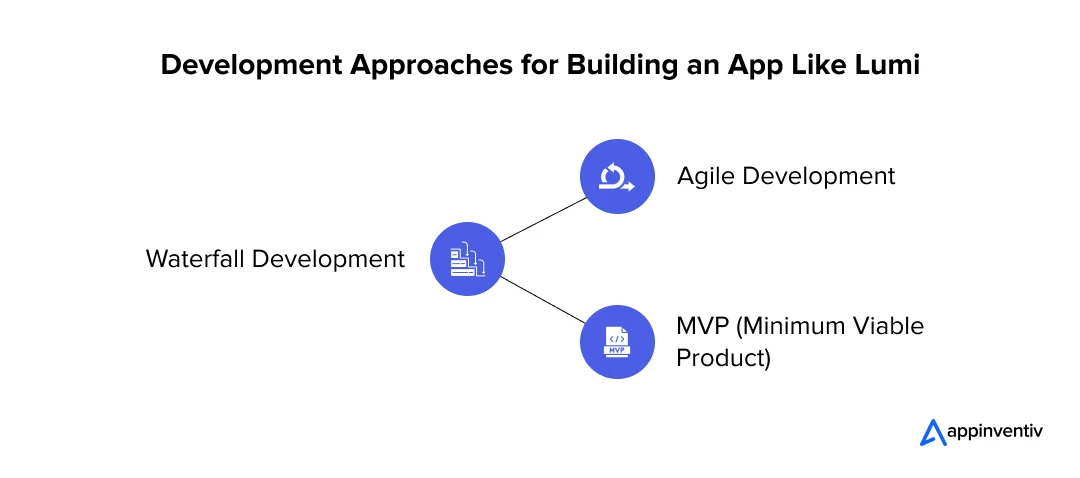
Agile Development (Most Recommended for Healthcare Apps)
Your Lumi by Nextcare app version can benefit from Agile development, ensuring that ongoing updates, such as adding new healthcare providers or integrating additional services (e.g., prescription delivery), are delivered efficiently.
Waterfall Development (Less Suitable for Healthcare Apps)
While Waterfall offers a clear roadmap from start to finish, changes to regulations, healthcare provider partnerships, and new user needs could quickly make the app obsolete or costly to update.
MVP (Minimum Viable Product)
Building an MVP can allow your app to provide essential healthcare services while collecting user feedback for future improvements if you plan to test a new market or roll out new services. In addition to helping entrepreneurs dry-run their concept, the approach can drastically reduce the cost of building a health insurance app like Lumi by Nextcare.
How to Earn Money From Your Lumi by Nextcare App
Lumi by Nextcare operates in healthcare, offering unique services such as virtual consultations, medical claim tracking, and more. Monetization strategies for these apps must balance profitability with providing valuable, accessible, and compliant healthcare services.
The models outlined below are proven approaches in the healthcare app sector, often recommended to clients aiming to build long-term, scalable revenue streams while remaining patient-centric and regulatory-compliant.
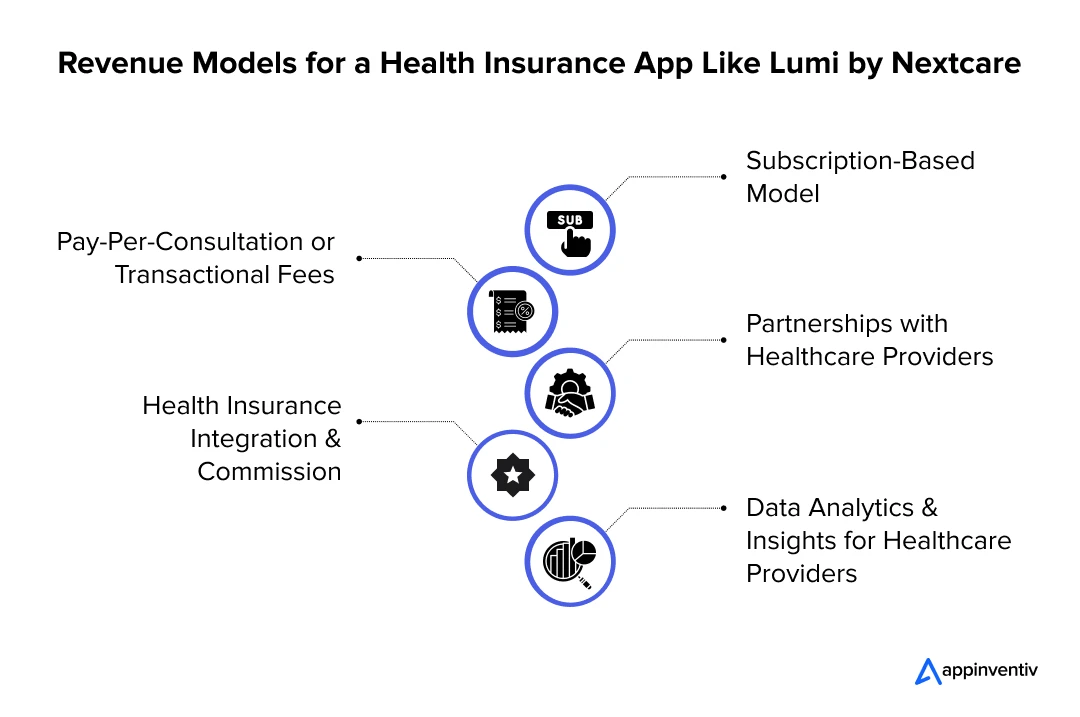
Subscription-Based Model
You can offer subscription packages for premium healthcare services, like unlimited consultations, priority access to doctors, or discounts on medical services.
Pay-Per-Consultation or Transactional Fees
Users can pay per healthcare service, such as video consultations, appointment booking, or medication delivery.
Partnerships with Healthcare Providers
You can also partner with healthcare clinics, pharmacies, or individual practitioners. Following these collaborations, you can earn a commission for each appointment booked or healthcare service used through the app.
Health Insurance Integration & Commission
Integrating insurance claims into the app allows you to earn a commission when users submit claims through the platform or when the app directs users to sign up with specific insurers.
Data Analytics & Insights for Healthcare Providers
You can provide anonymized patient data, such as trends in symptoms or treatments, to healthcare providers in exchange for a fee.
How can Appinventiv Elevate Your Healthcare App Development?
Developing an app like Lumi by Nextcare requires a deep understanding of healthcare-specific features, stringent compliance requirements, and user privacy concerns.
Appinventiv justifies being a trusted mobile app development company Dubai by bringing extensive experience in building healthcare solutions that are not only feature-rich but also meet the highest standards of data security and regulatory compliance – all the while ensuring that the Lumi by Nextcare app development cost is pocket-friendly.
Whether it’s telemedicine functionalities, appointment scheduling, or medical claims tracking, our team can design a solution tailored to your healthcare service’s needs. As a trusted provider of insurance software development services, we specialize in creating applications that ensure patient data privacy and comply with necessary healthcare regulations, including HIPAA. Our team can also assist in integrating advanced features like video consultations, AI-powered symptom checkers, and live tracking of medical claims.
Using the latest technologies and our expertise in healthcare app development, Appinventiv UAE ensures your platform delivers value to patients and healthcare providers while staying compliant with the regulatory landscape. Want to see us in action? Let’s connect.
FAQs
Q. How to build a healthcare app like Lumi by Nextcare?
A. To build a healthcare app like Lumi by Nextcare, you need a robust team of developers proficient in healthcare app development, data security protocols, and regulatory compliance. The key features, such as video consultations, appointment scheduling, medical claims tracking, and symptom checkers, should be integrated seamlessly. Moreover, compliance with healthcare regulations like HIPAA is critical to ensure privacy and data protection.
Q. How much does the Lumi by Nextcare app cost?
A. The cost to build a health insurance app like Lumi by Nextcare can range from $100,000 to $500,000, depending on the features and the level of customization required. The costs vary based on the complexity of the healthcare features, integrations with third-party services, and regulatory compliance needs.
Q. How much does it cost to build a wellness app?
A. The cost of building a wellness app can range between $50,000 to $200,000 or more, depending on the features involved. Basic wellness apps that offer tracking and basic fitness features tend to be on the lower end of the spectrum. In contrast, more advanced features like virtual consultations, health tracking, and integration with wearable devices can increase the cost.
Q. How long does it take to build a healthcare insurance app?
A. Building a healthcare insurance app typically takes 6 to 12 months, depending on the features and regulatory requirements involved. Apps with features like policy management, claims tracking and provider search can take longer due to the complexity and integration needs.


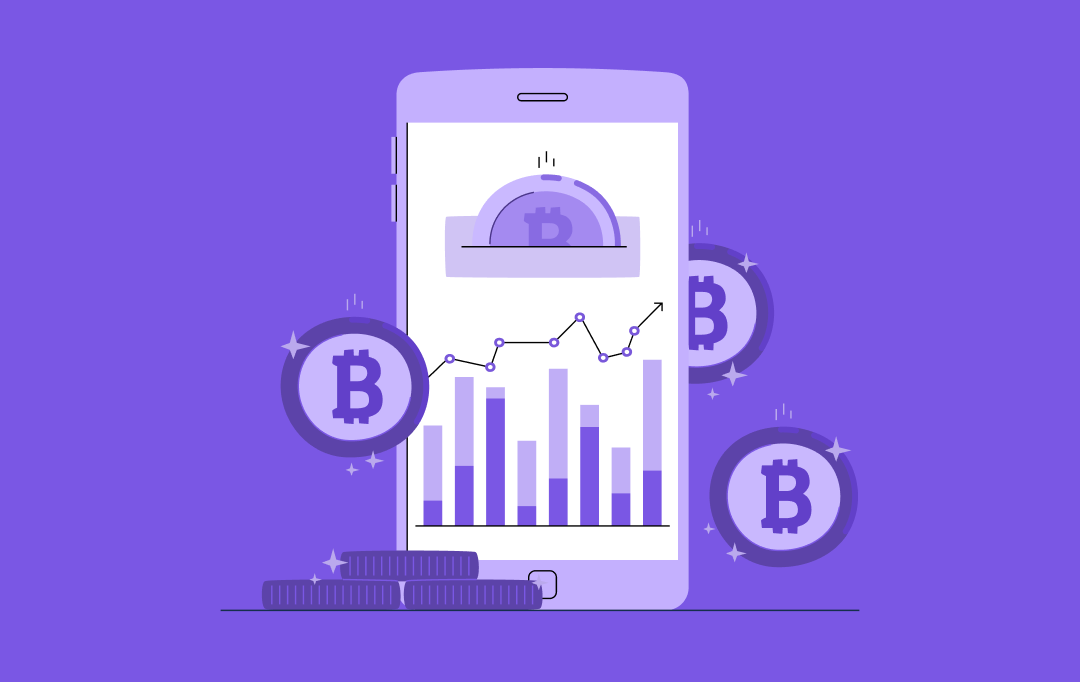
How Much Does It Cost to Build a Crypto Exchange App Like BitOasis in the UAE?
Key takeaways: The cost to build a crypto exchange app in the UAE ranges from $50,000 to $200,000. UAE regulations (VARA and Central Bank) impact development costs due to compliance needs. Advanced features like AI fraud detection increase development costs. The UAE crypto market is expected to grow significantly, offering huge potential. MVP and cross-platform…
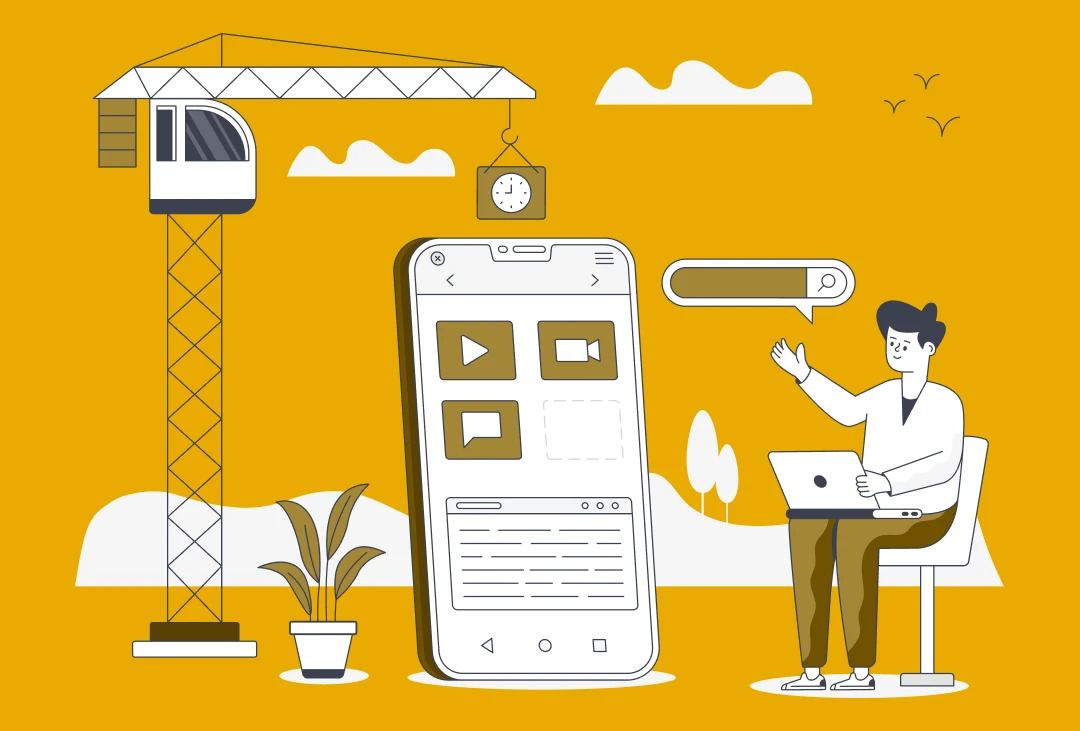
How Much Does It Cost to Build An App Like Kayo Sports in Australia?
Key takeaways: Wide Cost Range: Developing a Kayo Sports-like app in Australia can cost between AUD 45,000 (MVP) and over AUD 750,000 for a full-featured, scalable platform. Feature Complexity Impacts Budget: High-end features, such as multi-view streaming, AI personalization, and multi-device support, significantly increase development costs. Ongoing Hidden Costs: Content licensing, cloud infrastructure, compliance, and…
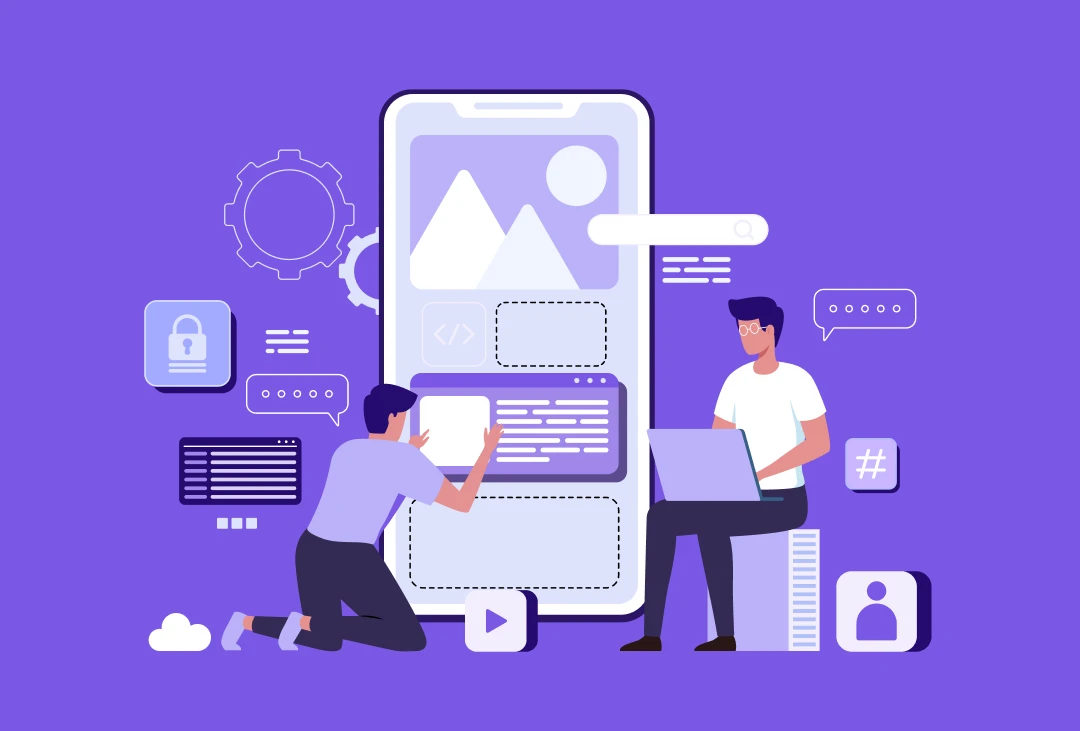
How Much Does It Cost To Build An App in Singapore?
Key takeaways: Mobile app development costs in Singapore range from SGD 40,000 to over SGD 530,000, depending on complexity, platform, and features. Basic apps start at: SGD 40,000. High-end apps using advanced technologies like AI or blockchain can exceed SGD 530,000. Key factors such as platform selection (iOS, Android, Cross-Platform), app complexity (basic, medium, high),…






